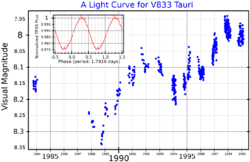Astronomy:HD 283750
Coordinates: ![]() 04h 36m 48.2413s, +27° 07′ 55.8983″
04h 36m 48.2413s, +27° 07′ 55.8983″
 A light curve for V833 Tauri. The main plot (adapted from Strassmeier et al.[1] and Oláh et al.[2]) shows the long term visual band variation, and the inset plot (plotted from TESS data[3]) shows the periodic variability. | |
| Observation data Equinox J2000.0]] (ICRS) | |
|---|---|
| Constellation | Taurus |
| Right ascension | 04h 36m 48.2413s[4] |
| Declination | 27° 07′ 55.8983″[4] |
| Apparent magnitude (V) | 8.02 - 8.40[5] |
| Characteristics | |
| Evolutionary stage | Main sequence |
| Spectral type | K5Ve[6] |
| B−V color index | 1.12[6] |
| Variable type | BY Dra + Flare[5] |
| Astrometry | |
| Radial velocity (Rv) | 42±3[7] km/s |
| Proper motion (μ) | RA: 232.17±0.06[7] mas/yr Dec.: -147.48±0.04[7] mas/yr |
| Parallax (π) | 57.49 ± 0.05[7] mas |
| Distance | 56.73 ± 0.05 ly (17.39 ± 0.02 pc) |
| Details[6] | |
| Mass | 0.8 M☉ |
| Radius | 0.8 R☉ |
| Surface gravity (log g) | 4.5 cgs |
| Temperature | 4250±100 K |
| Rotational velocity (v sin i) | 7.4 km/s |
| Age | 1[8] Gyr |
| Other designations | |
| Database references | |
| SIMBAD | data |
HD 283750, also known as V833 Tauri, is a K-type main-sequence star 57 light-years away from the Sun. The star is much younger than the Sun's at 1 billion years.[8] HD 283750 is similar to the Sun in its concentration of heavy elements.[6]
The star has a co-moving white dwarf companion WD 0443+270 at a projected separation of 124″,[9] both possibly ejected members of the Hyades cluster. The white dwarf companion has a rather exotic iron core[8] and belongs to spectral class DA9 and has the mass of 0.62±0.02M☉.[10]
Although HD 283750 was classified as a multi-period variable,[11] a paper in 2020 claims its variability is not exceeding the variability of the Sun, and no period can be identified.[12]
HD 283750 is covered by a large amount of starspots, filling up to 28% of the stellar surface at the maxima of the magnetic cycle.[13] In November 1993, the star emitted an extremely powerful flare with energy of 7.47×1034 ergs, which is on or even above the upper limit of possible energy releases in flare stars.[11] The flares of HD 283750 are accompanied by particle beams strong enough to affect the polarization properties of the stellar photosphere.[14]
Suspected substellar companion
In 1996 a suspected 50-MJ brown dwarf HD 283750b on a 1.79-day orbit around HD 283750 was detected by the differential Doppler spectroscopy method. By 2007, the mass of the companion was refined to 0.19M☉, making it a red dwarf star.[15]
References
- ↑ Strassmeier, K. G.; Bartus, J.; Cutispoto, G.; Rodono, M. (October 1997). "Starspot photometry with robotic telescopes: Continuous UBV and V(RI)_C photometry of 23 stars in 1991-1996". Astron. Astrophys. Suppl. Ser. 125 (1): 11–63. doi:10.1051/aas:1997369. Bibcode: 1997A&AS..125...11S. https://aas.aanda.org/articles/aas/abs/1997/13/ds1287/ds1287.html. Retrieved 29 June 2022.
- ↑ Oláh, K.; Kolláth, Z.; Strassmeier, K. G. (April 2000). "Multiperiodic light variations of active stars". Astronomy and Astrophysics 356: 643–653. Bibcode: 2000A&A...356..643O. https://articles.adsabs.harvard.edu/pdf/2000A%26A...356..643O. Retrieved 29 June 2022.
- ↑ "MAST: Barbara A. Mikulski Archive for Space Telescopes". Space Telescope Science Institute. https://mast.stsci.edu/portal/Mashup/Clients/Mast/Portal.html.
- ↑ 4.0 4.1 4.2 "HD 283750". SIMBAD. Centre de données astronomiques de Strasbourg. http://simbad.u-strasbg.fr/simbad/sim-basic?Ident=HD+283750.
- ↑ 5.0 5.1 "V833 Tauri". AAVSO. https://www.aavso.org/vsx/index.php?view=detail.top&oid=35850.
- ↑ 6.0 6.1 6.2 6.3 Naftilan, S. A.; Fairchild, K. (1993). "Abundance Analysis of the BY Draconis Variable, Hot Flare Star V833 Tauri". Publications of the Astronomical Society of the Pacific 105: 565. doi:10.1086/133194.
- ↑ 7.0 7.1 7.2 Brown, A. G. A. (2021). "Gaia Early Data Release 3: Summary of the contents and survey properties". Astronomy & Astrophysics 649: A1. doi:10.1051/0004-6361/202039657. Bibcode: 2021A&A...649A...1G. Gaia EDR3 record for this source at VizieR.
- ↑ 8.0 8.1 8.2 Catalán, S.; Ribas, I.; Isern, J.; García-Berro, E. (2007), "WD0433+270: An old Hyades stream member or an Fe-core white dwarf?", Astronomy & Astrophysics 477 (3): 901–906, doi:10.1051/0004-6361:20078230
- ↑ Scholz, R.-D.; Meusinger, H.; Jahreiß, H. (2018), "New nearby white dwarfs from Gaia DR1 TGAS and UCAC5/URAT", Astronomy & Astrophysics 613: A26, doi:10.1051/0004-6361/201731753, Bibcode: 2018A&A...613A..26S
- ↑ Toonen, S.; Hollands, M.; Gänsicke, B. T.; Boekholt, T. (2017), "The binarity of the local white dwarf population", Astronomy & Astrophysics 602: A16, doi:10.1051/0004-6361/201629978, Bibcode: 2017A&A...602A..16T
- ↑ 11.0 11.1 Oláh, K.; Strassmeier, K. G.; Kővári, Zs.; Guinan, E. F. (2001). "Time-series photometric spot modeling. IV. The multi-periodic K5Ve binary V833 Tauri". Astronomy & Astrophysics 372: 119–129. doi:10.1051/0004-6361:20010362. Bibcode: 2001A&A...372..119O.
- ↑ Frick, P.; Sokoloff, D.; Katsova, M. M.; Bondar', N. I.; Stepanov, R. (2020). "Wavelet analysis of the long-term activity of V833 Tau". Monthly Notices of the Royal Astronomical Society 495 (4): 3788–3794. doi:10.1093/mnras/staa1458.
- ↑ Bondar', N. I. (2017). "Photometric period and rotational brightness modulation of V833 Tau". Astronomy Reports 61 (2): 130–137. doi:10.1134/S1063772917010024. Bibcode: 2017ARep...61..130B.
- ↑ Saar, S. H.; Martens, P. C. H.; Huovelin, J.; Linnaluoto, S. (1994). "Possible detection of a stellar flare-generated particle beam in polarized light". Astronomy and Astrophysics 286: 194. Bibcode: 1994A&A...286..194S.
 |

